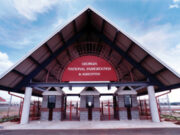The Georgia National Fairgrounds and Agricenter in Perry, the seat of Houston County, has been educating and entertaining people with its state fair and agricultural programs since its opening in 1990. The $26.2 million facility has since drawn hundreds of millions of dollars into Georgia’s economy.
Georgia state representatives Larry Walker, from Perry, and Henry Reaves, from Quitman, conceived of the facility in 1985 as a way to promote Georgia agribusiness. The fairground and agricenter originally occupied 628 acres, but the facility has nearly doubled in size to 1,100 acres. The agricenter contains 10 acres of exhibition space with 2 arenas, 3 exhibit halls, a 480-stall horse barn, 4 ponds, a carnival midway, and parking for 13,000 vehicles. In addition to the state fair, more than 260 other events are held annually at the facility, including gun shows, motocross, rodeos, and wrestling.
The Georgia National Fair is held over a ten-day period each October. Attendance in 2004 was 390,000. Events include horse shows and displays of such livestock as sheep, rabbits, swine, and chickens, as well as demonstrations of sheepherding, milking, and honey-making. The Georgia Living Center features home and fine arts competitions, and the Georgia National Schoolhouse, a living history museum, showcases a century of Georgia farm life along with exhibitions of various agricultural commodities, including the award-winning display “Stories of Agriculture.” Members of such youth programs as 4-H, the Family Career Community Leaders of America (FCCLA), Future Farmers of America (FFA), and the Technology Student Association (TSA) are invited to exhibit and compete in equine, livestock, and poultry shows.
The fair has won more than fifty awards for its agricultural events and education programs, including recognition as a “Top 20 Event for October” from the Southeast Tourism Society.




